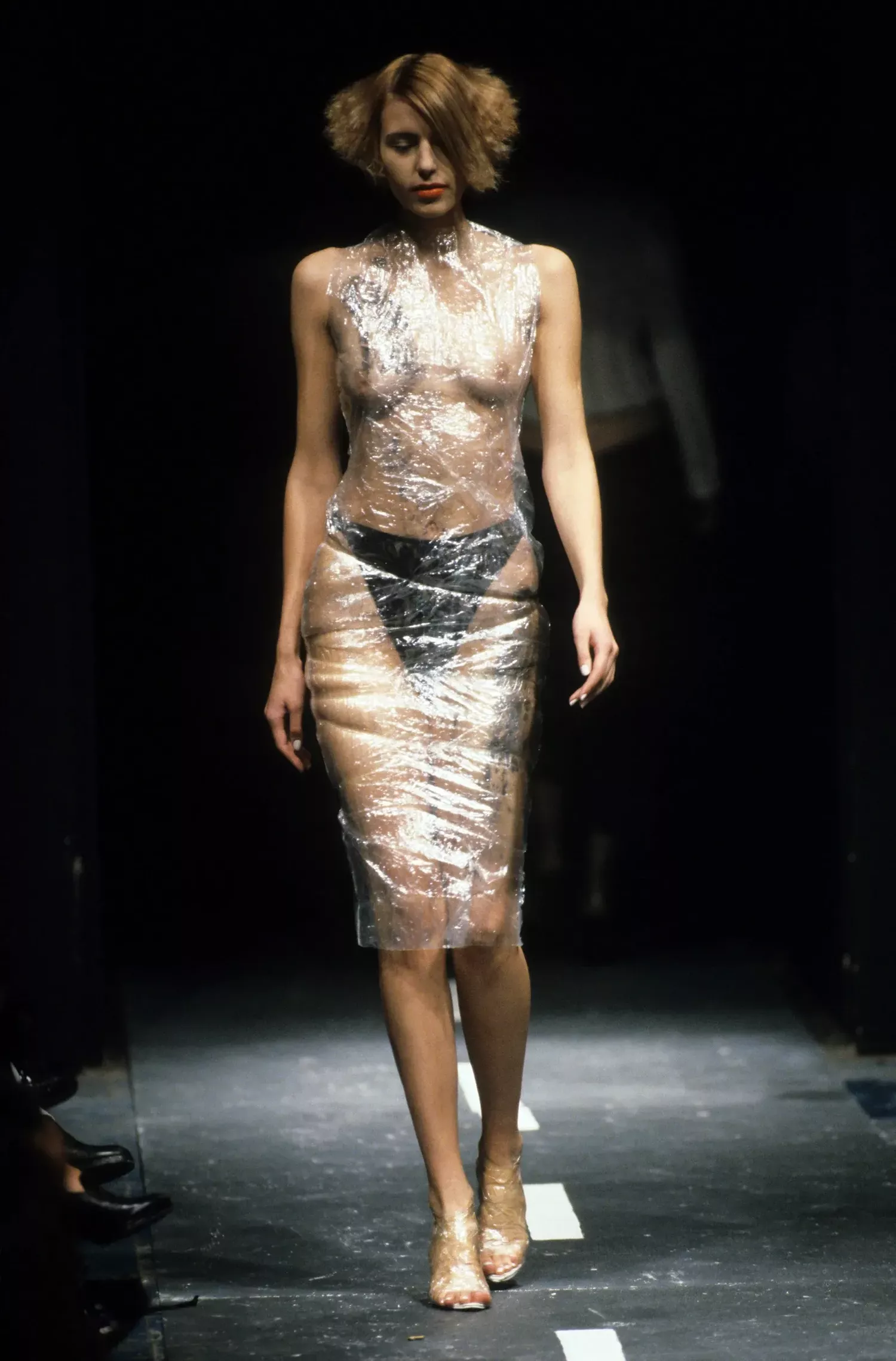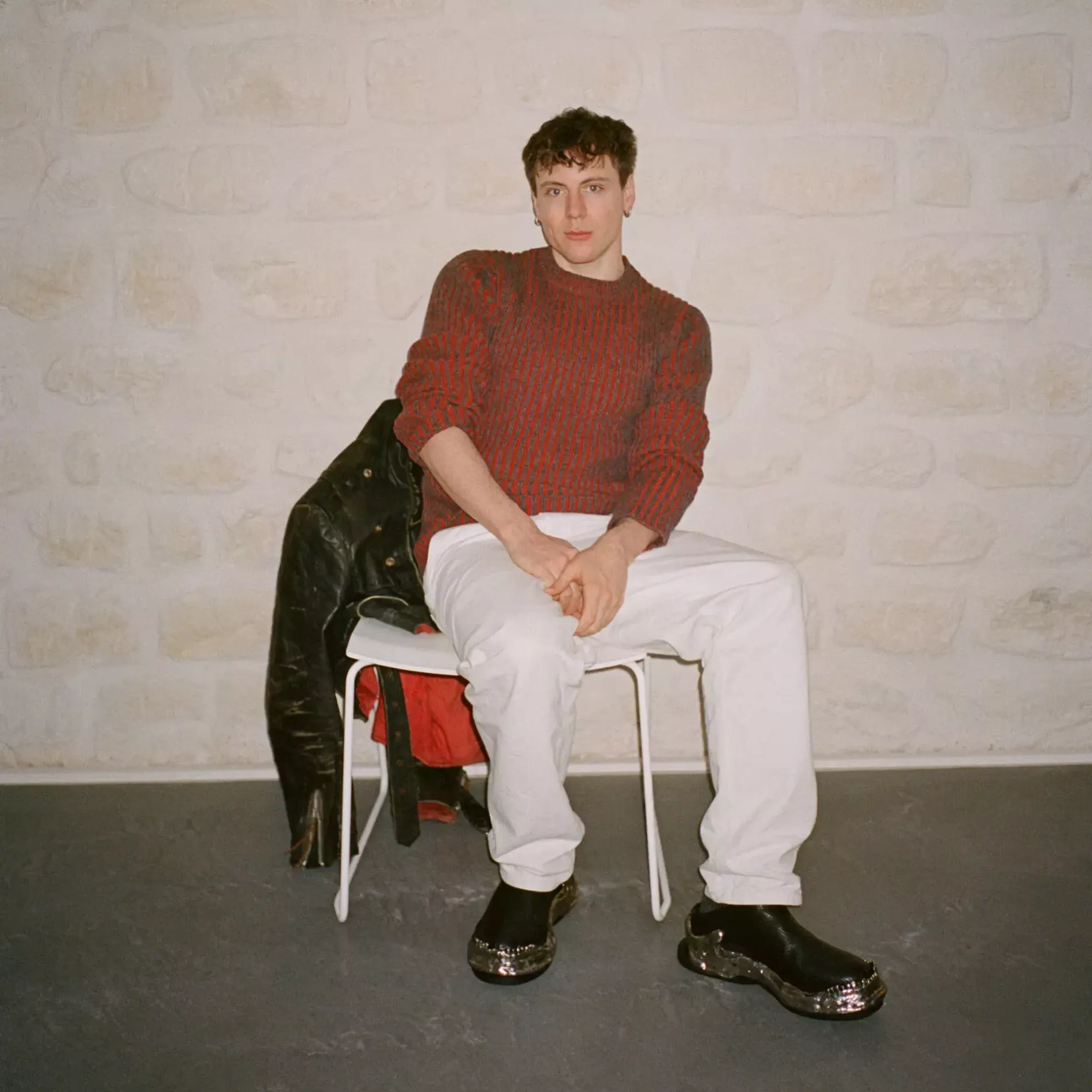Ahead of his much-anticipated debut at the British house, the designer talks improvisation, youth culture and “playful aggression”.
“For me, it’s about letting the light in.” Seán McGirr is in the midst of final fittings in Paris. His debut show for Alexander McQueen is in four days’ time. Downstairs, models are queuing up to be seen, and boxes of clothes are being bustled in and out of the front door, blasts of February air chilling the otherwise frenetic atmosphere. But upstairs, where McGirr is at work, all is calm.
Reference boards stand against one wall. David Hammons’s tarp paintings, John Chamberlain’s car sculptures, and pictures of his own iPhone, its screen cracked into a million tiny pieces, are arrayed in orderly rows. Interspersed here and there are photos of young Londoners then and now – like Kate Moss in her Pete Doherty days and Amy Winehouse wearing her highest beehive and lowest cut bustier dress, and Bebe Parnell, a current Oxford student he plans to put in his first show. Rows of shoes and boots march across the shelves, including distinctive clodhoppers modelled after horse hooves. And on the racks are the looks that have been decided upon – the tartans you would expect and other artfully, elaborately embellished pieces that will be more of a surprise.
“I started by looking at the 'Birds' collection,” McGirr told me a little over a week earlier in his London studio, referring to the spring/summer 1995 Lee Alexander McQueen show that resonates most for him. “What I like about it is that it’s all very simple, but it’s slightly twisted. It’s a jacket with a more stacked shoulder, or the lapel goes up a little too high. It’s the idea of making beautiful tailoring and then running a tyre over it to make something new. Taking something and twisting it and crushing it and seeing what happens.”

The spring/summer 1995 Lee Alexander McQueen Birds collection that gave Seán McGirr much of his inspiration. Photo: Condé Nast Archive
McGirr’s job, of course, is to bring newness to Alexander McQueen. When the posting was announced, Gianfilippo Testa, the label’s CEO, said: “He will bring a powerful creative language to [the brand].” To do so, he’ll inject his millennial point of view. “For me, it has to have a youthful energy. I think it should be about London, this mix of youth culture that I see all the time here. I want that to be represented.” Also, “It has to provoke a reaction; that’s the DNA of the brand. McQueen is also about aggression, but playful aggression.”
Will there be bumsters? The hip-slung, ass crack-revealing pants McQueen was notorious for have been turning up on other runways this season. But McGirr isn’t doing anything that literal. Instead, he says he graded up a pair from the archives 10 times. “For me, this is a modern version. They’re still super, super low, but they’re loose, and you wear them in a cool way.” The new McQueen, he says, “shouldn’t feel too hard to live in”.
Growing the ready-to-wear is a crucial part of the gig; McGirr says a big part of the current business is one sneaker. There’s a lot of opportunity in that, especially for someone as confident as McGirr. “I’ve always had a lot of conviction in what I’ve done,” he says. “I moved to London when I was 17, a week after school, and my parents were really supportive because I had conviction.”
Now 35, McGirr was one of those alternative London kids he’s talking about when McQueen died by suicide in 2010 – an Irish import on the verge of applying to Central Saint Martins to pursue a job in fashion. 'Horn of Plenty' and 'Plato’s Atlantis', McQueen’s final two shows, had made an impression. “I was 20… it was my formative year, and those two shows instilled a lot of inspiration. Plato’s Atlantis was just very bold, with such a strong message. That show had an effect on me, and it had a really strong effect on culture, with Lady Gaga and ‘Bad Romance’. It really was in the fabric.”
He grew up in a “pretty banal, quite conventional” suburb of Dublin with parents who worked hard; his mum as a nurse and his dad as a mechanic (both of his parents, as well as his younger brother and sister, will be at the show). “I wasn’t really around fashion; what introduced me to it were films,” he says. His dad was into Tarantino and showed him Reservoir Dogs and Pulp Fiction. “These characters who were on the fringes, the outsiders, slightly dangerous – I thought they were really cool.” Before that, McGirr had wanted to be a journalist, but movies helped him realise that you could say what you want to say through clothes. “That’s why I love McQueen so much because there’s always a message in the clothes,” he says. It was his grandmother, a window dresser in the ’50s and ’60s, who introduced him to sewing. He started buying vintage clothes and reworking them and tailored his school uniform. “This idea of improvisation – I wanted to say something by how something fits. That was something that really appealed to me.”

The spring/summer 1995 Lee Alexander McQueen Birds collection that gave Seán McGirr much of his inspiration. Photo: Condé Nast Archive
On his arrival in London, he took a job at a shoe shop in Oxford Street, but it didn’t last long. “I experienced something kind of homophobic. Some of the staff were a bit rude to me because they knew I was gay. I called my mum, she was like, ‘Get out of there’. So I went to a gay bar that night and started working there.”
Later, thanks to a tip from Louise Wilson, Central Saint Martins’s legendary professor of fashion design, he applied for and secured a scholarship and graduated from the school in 2014.
Alums five or 10 years ahead of him, like Simone Rocha, Christopher Kane and Jonathan Saunders, launched brands straight out of school, but McGirr and his classmates graduated on the other side of the Great Recession. Most went after jobs at big companies, and McGirr chose one of the biggest: Tokyo’s Fast Retailing, the owner of Uniqlo, where he worked on the Uniqlo U line with Christophe Lemaire. “It was really inspiring to live in Japan,” he says. “It’s such a different culture, but they’re island people like Irish people. We’re both a bit weird.”
After a stint in Antwerp working for Dries Van Noten, he moved back to London to join the JW Anderson team, starting with the men’s collection before taking over women’s as well as head of ready-to-wear. In addition to Anderson, he names John Galliano, Rick Owens, and Japanese designers Junya Watanabe, Issey Miyake and Rei Kawakubo among the designers he admires: “People who see things in a more unconventional way, who try and push ideas forward, or change how you see things.”
Of his working style, he says, “I was a designer for 10 years, I still am, and I’m used to working with teams of kids and giving people a lot of space, but also I like to be quite involved.” Other than stylist Marie Chaix and an assistant, everyone on the team predates his arrival, and many worked with Lee himself. “We’re all just excited to do something new. I think I’m quite open with creative people, and I can be flexible. They’re getting into what I like, and I’m trying to see what they’re really skilled at.”
McGirr lives in baggy Dickies, Saint James knits and matching diamond huggie hoops that set off his blue eyes. In conversation, he maintains eye contact better than just about anyone I’ve encountered, and on his feet, he moves across the studio with easy athleticism. He swims, and in the run-up to the show, he’s been practising yoga.
McGirr’s appointment sparked online sturm and drang — it was another man in another top design job, and this one particularly stinging because he was replacing the beloved Sarah Burton, who worked side by side with McQueen before his death. McGirr is respectful of Burton. “The vocabulary that McQueen put out there, that’s what Sarah was so amazing at; she carried that verve and amplified the codes.” And his response to the consternation his arrival stirred up seems aligned with his collaborative, getting-his-hands-dirty approach. “Obviously,” he says, “it’s very complex. But to be honest, I’m really happy and really proud that my announcement sparked this discussion about diversity. I’ve worked around the world, and I’ve always noticed that diversity breeds creativity. I think it’s really important to keep that conversation going.”
Related: Chemena Kamali talks Chloé: Karl, freedom, Phoebe, empathy, and the enduring appeal of the 1970s

The spring/summer 1995 Lee Alexander McQueen Birds collection that gave Seán McGirr much of his inspiration. Photo: Condé Nast Archive
Last month, McGirr released a teaser campaign, shot by the artist Tommy Malekoff and starring Debra Shaw and Frankie Rayder, both of whom walked in Lee McQueen’s shows. It reintroduced a logo sketched by McQueen (the one with the c inside the Q) and brought back the skull – a house icon. “It was sort of a play on the gothic traditions of the house,” he says. “I wanted to do something that was very raw – a little bit playful, a little bit aggressive.” It stirred online chatter, as opening salvos always tend to do, and the talk was mixed, but again, he’s equanimous about the reactions. “It divided people a bit. I think that’s cool, I think it’s important. Lee McQueen said in the ’90s, ‘I’d rather have people hate it than not feel anything.’ I think McQueen is a little bit like that.”
A provocateur by nature, McQueen was comfortable with darkness but don’t expect the same from McGirr. “Fashion should really excite people, but in an optimistic way,” he says. “I’m not really into sadness or gloominess. To be honest, I think the world’s mental health is super low. Fashion should be able to conjure up feelings that are a bit twisted,” – at the Paris preview, the words he used were “rough glamour” – “but inspire you at the same time.”
To maintain his own sense of balance, he removed his profile from Instagram last year. “I used to really enjoy it, but then I decided I wouldn’t be on it, mostly because I want to stay focused on the work. I think it’s healthier for me to stay off it.” He also does analysis once a week. “It’s quite good for me to kind of contextualise and understand what I’m trying to tap into and deeply think about things.” His analyst is Jungian, not Freudian, he points out. “I’m quite interested in the human mind. How we work, our psyche, why we come to things. You know, we live in a world that’s very reactive now. It’s always interesting to kind of think a bit deeper, to understand where things actually come from.”
Where he’s taking us tonight is Olympiad, a former wholesale food market in the heart of Paris’s Chinatown. He wanted something a bit industrial and in keeping with the McQueen tradition of presenting far from Paris’s bourgeois centre. In the lead-up to the show, McGirr was pure emotion. “I think McQueen was the greatest designer that ever lived, really. So, it’s exciting; I’m just excited for the future.”
Originally published on Vogue Business.
